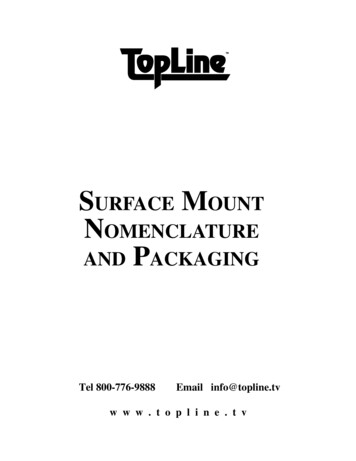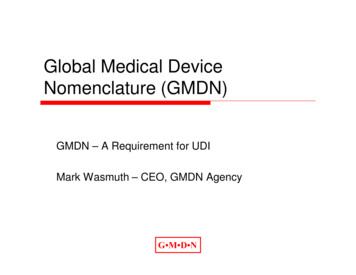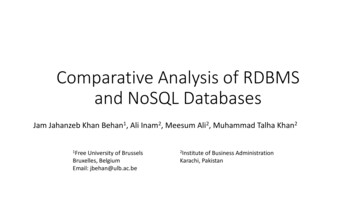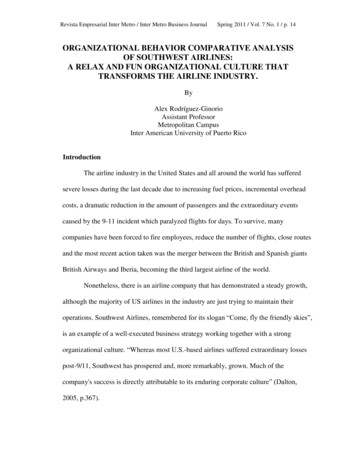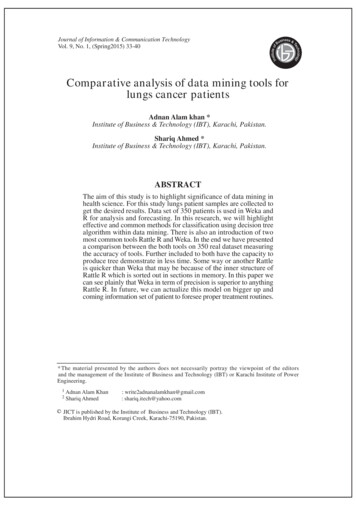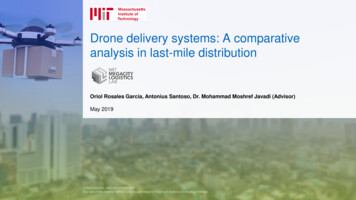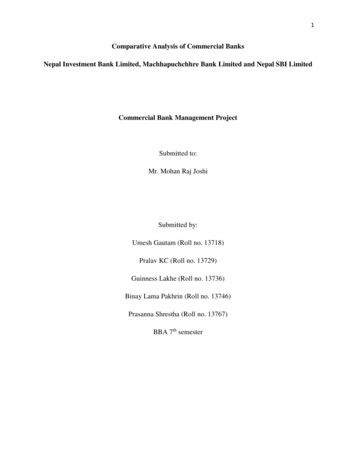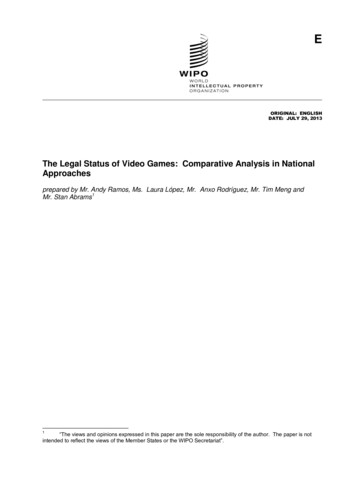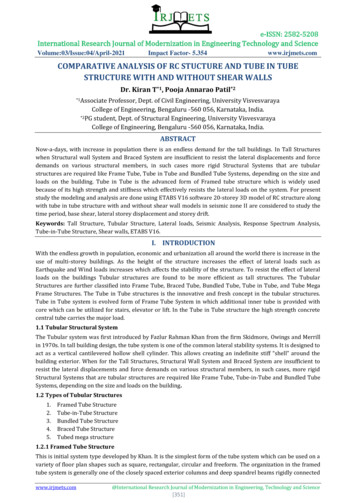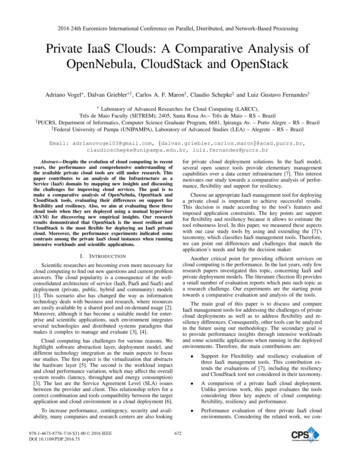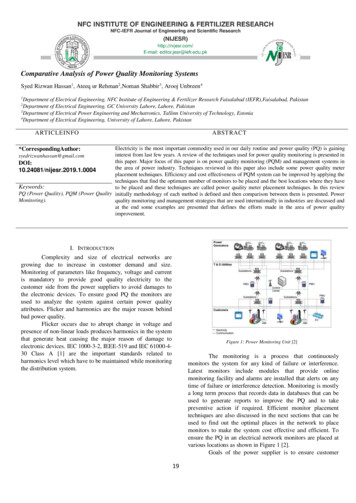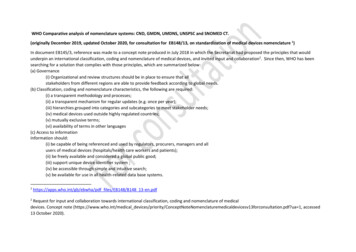
Transcription
WHO Comparative analysis of nomenclature systems: CND, GMDN, UMDNS, UNSPSC and SNOMED CT.(originally December 2019, updated October 2020, for consultation for EB148/13, on standardization of medical devices nomenclature 1)In document EB145/3, reference was made to a concept note produced in July 2018 in which the Secretariat had proposed the principles that wouldunderpin an international classification, coding and nomenclature of medical devices, and invited input and collaboration2. Since then, WHO has beensearching for a solution that complies with those principles, which are summarized below:(a) Governance(i) Organizational and review structures should be in place to ensure that allstakeholders from different regions are able to provide feedback according to global needs.(b) Classification, coding and nomenclature characteristics, the following are required:(i) a transparent methodology and processes;(ii) a transparent mechanism for regular updates (e.g. once per year);(iii) hierarchies grouped into categories and subcategories to meet stakeholder needs;(iv) medical devices used outside highly regulated countries;(v) mutually exclusive terms;(vi) availability of terms in other languages(c) Access to informationInformation should:(i) be capable of being referenced and used by regulators, procurers, managers and allusers of medical devices (hospitals/health care workers and patients);(ii) be freely available and considered a global public good;(iii) support unique device identifier system ;(iv) be accessible through simple and intuitive search;(v) be available for use in all health-related data base systems.12https://apps.who.int/gb/ebwha/pdf files/EB148/B148 13-en.pdfRequest for input and collaboration towards international classification, coding and nomenclature of medicaldevices. Concept note (https://www.who.int/medical icesv13forconsultation.pdf?ua 1, accessed13 October 2020).
OrganizationGovernanceClassification, coding and nomenclaturecharacteristicsAccess to informationand convergenceRemarksECRI Institute1ECRI is a not-for-profit organization.Although the ECRI Institute hasdedicated full- and part-time stafffor maintenance and developmentof the UMDNS, it does not have atransparent review and feedbackmechanism for definingnomenclature/codes. Somefeedback is taken from users whohave paid for licenses to use otherECRI products. Regulators are notengaged in nomenclature review inany structured manner.(i) There is transparency in terms of publicdisclosure of approved codes; however, access tothe mechanisms for establishment of these codes isonly open to the ECRI and not to other stakeholders.(ii) The periodicity of updates is dynamic and doesnot take place in a pre-set manner; however,updates are known to only the users of the UMDNS.(iii) There is a polyhierarchical taxonomy, composedof a main hierarchy and sets of attributes, which issuitable for generating alternative views andhierarchies. The hierarchy is rigid, with tags, flags,attributes and cross-connections between terms.(iv) There is non-discriminatory inclusion of medicaldevices across all categories available to licensedusers.(i) Starting from 15th ofOctober 2019, ECRIannounced that UMDNSfree access will be subjectto subscription and not freeany more. Many users mayalso need to purchase otherECRI products to have fullutility of codes and accessto complete information.Hierarchy, structure andrelationships between terms arenot freely available.Users need to purchase asubscription in order to be able tofully obtain, update and implementthe UMDNS.The nomenclature is apolyhierarchical taxonomy, flexibleand suitable for variouscategorization and classificationapproaches.(v) The UMDNS is available in two United Nationslanguages (English and Spanish) and German, withthe cost of further such translation falling on theuser community.1(ii) Code research,definitions and code list areavailable.(iii) UMDNS is not currentlyrequired by any jurisdictionto be assigned to the deviceidentifier of UDI (UDI-DI)ECRI Institute comments on the WHO concept note and proposal for collaboration on international nomenclature, coding and classification of medical devices areavailable at https://www.who.int/medical devices/priority/ECRI.pdf?ua 1 (accessed 13 October 2020).
OrganizationGovernanceClassification, coding and nomenclaturecharacteristicsAccess of informationand convergenceRemarksGMDN Agency1The GMDN Agency is a not-for-profitorganization with its own staff. Itdoes not have a transparent reviewand feedback mechanism fordefining nomenclature/codes. Somefeedback is taken from users withlicenses. It is free for regulatoryagencies and other users for adefined package. Regulators are notengaged in nomenclature review inany structured manner.(i) mechanisms for defining nomenclature and codesare privy only to GMDN and are not available toother stakeholders.(ii) The periodicity of updates is dynamic and doesnot take place in a pre-set manner(i) Free for variousstakeholders, includingregulators, for definedpackages.GMDN nomenclature is not freefor all stakeholders.Non-paying users can only searchand access individual codes on theGMDN website. The structure,hierarchy and relationships are notfreely available for consultationand download, so the publiccannot take advantage of theGMDN hierarchy for analysispurposes.(iii) The taxonomy is polyhierarchical, composed ofa main hierarchy and sets of attributes.(iv) medical devices hierarchy across all categories isavailable to licensed users.(v) Some terms are available in 23 languages,including four official United Nations languages.(ii) Each package hasdistinct characteristics interms of access toinformation.(iii) Not free formanufacturers andconsultants.(iv) Researchers andacademics cannot usemultiple-user licensesImplementation of GMDNnomenclature requiressubscription.(v) GMDN is currentlyrequired by certainjurisdictions to be assignedto the device identifier ofUDI (UDI-DI) and is madepublicly available throughthe US Global UDI Database(GUDID).1GMDN Agency comments on the WHO concept note and collaboration proposal for international nomenclature, coding and classification of medical devices are availableat https://www.who.int/medical devices/priority/GMDN Agency.pdf?ua 1 (accessed 13 October 2020).
OrganizationGovernanceClassification, coding and nomenclaturecharacteristicsAccess of informationand convergenceRemarksGS11International, not-for-profitorganization that develops andmaintains standards for businesscommunication. GS1 is a businessprocess developer which uses anidentification method common to allgoods/products(i) Nomenclature is developed for the trading sectorand includes all possible goods and services – notspecific to medical devices.(i) Free to a limited extent.GPC nomenclature is managed byGS1 with no fully open andtransparent review process andcriteria. GPC is a generalnomenclature for trading, notspecifically developed for thehealth sector.The structure and hierarchy arerigid, and this structure does notmeet the need for flexibilityrequired by the health sector.(ii) Rigid codes are additive and include the fullhierarchy path.(iii) The creation of codes is only in the purview ofGS1 and the process is not known or shared withstakeholders.(ii) Does not include manycategories of medicaldevices and the list it coversis restrictive dependingupon the trade needs.(iii) Unique productidentification is possible butnot specific to medicaldevices.(iv) Access is subscriptionbased(v) GPC is not currentlyrequired by any jurisdictionto be assigned to the deviceidentifier of UDI (UDI-DI)1GS1 comments on the WHO concept note and collaboration proposal for international nomenclature, coding and classification of medical devices are available athttps://www.who.int/medical devices/priority/GS1.pdf?ua 1 (accessed 13 October 2020).
OrganizationGovernanceClassification, coding and nomenclaturecharacteristicsAccess of informationand convergenceRemarksSNOMEDInternational1A not-for-profit entity founded bythe governments of Australia,Canada, Denmark, Lithuania,Sweden, the Netherlands, NewZealand, the United Kingdom andthe United States. Members ofSNOMED International can be anagency of a national government, oranother body (such as a corporationor regional government agency)endorsed by an appropriate nationalgovernment authority within theterritory it represents. Members playa critical governance role throughthe approval of the organization'sbudget and strategy.(i) Development and update criteria are not fullypublished.(i) Free access only allows fordownloading of the current codeset, not the framework.SNOMED CT wasdeveloped for healthrecords and is not theoptimal solution forregulatory, managementand procurement purposesrelated to medical devices.(ii) Ontology and terms are unique, and hierarchy isgenerated by a set of relationships.(iii) Intended for use in electronic healthrecords/clinical records and focuses primarily onhealth care interventions with the purpose ofcapturing information in clinical records. As part ofthis process, terminologies for health products arealso captured.(iv) Available in five languages(ii) Free for institutions fromterritories that have become paidmembers of the consortium.(iii) The list of codes is available, butthe methodology for codegeneration/modification is notavailable.(iv) Requires members to developextension pathways fornomenclatures, as per their needs.(v) Participation is limited bysubscription/membership.(vi) SNOMED is mapped to a subsetof GMDN terms and through thatconnection is currently mapped incertain jurisdictions to the deviceidentifier of UDI (UDI-DI)1SNOMED International comments on the WHO concept note and collaboration proposal for international nomenclature, coding and classification of medical devices areavailable at https://www.who.int/medical devices/priority/SNOMED.pdf?ua 1 (accessed 13 October 2020).
OrganizationGovernanceClassification, coding and nomenclaturecharacteristicsAccess of informationand convergenceRemarksCND1Developed by the Italian Ministry ofHealth, and adopted by theEuropean Commission to help fulfilthe regulatory requirement in thenew European Union regulations(i) Nomenclature developed and managedspecifically for medical devices by Italian Ministry ofHealth.(i) Freely available on the website inItalian and in English.(i) The EuropeanCommission has informedWHO that it will beadopting the CND.(Responsibleorganization:ItalianMinistry ofHealth)(ii) methodology of coding, classification andupdating is done through a structured process whichinvolves stakeholders.(iii) transparent methodology, processes for theclassification, coding and establishment ofnomenclature terms.(iv) Codes are additive and include the full hierarchypath.1(ii) Although it is not based on aninteractive platform, it isdownloadable.(iii) other countries which adoptedCND (Greece and Portugal) carriedout the translations (iv) Nonsubscription/ license based.(v) CND will be used as the basis fordeveloping the EMDN. EMDN isrequired by the EuropeanCommission to be assigned to thedevice identifier of UDI (UDI-DI) aswill be available as part of thepublicly available European UnionUDI Database (Eudamed)More information on the CND from the Italian Ministry of Health (in Italian) is available athttp://www.salute.gov.it/portale/temi/p2 6.jsp?lingua italiano&id 328&area dispositivi-medici&menu classificazione (accessed 13 October 2020).
13.10.2020 · definitions and code list are available. (iii) UMDNS is not currently required by any jurisdiction to be assigned to the device identifier of UDI (UDI-DI) Hierarchy, structure and relationships between terms are not freely available. Users need to purchase a subscription in order to be able to fully obtain, update and implement the UMDNS. The nomenclature is a
